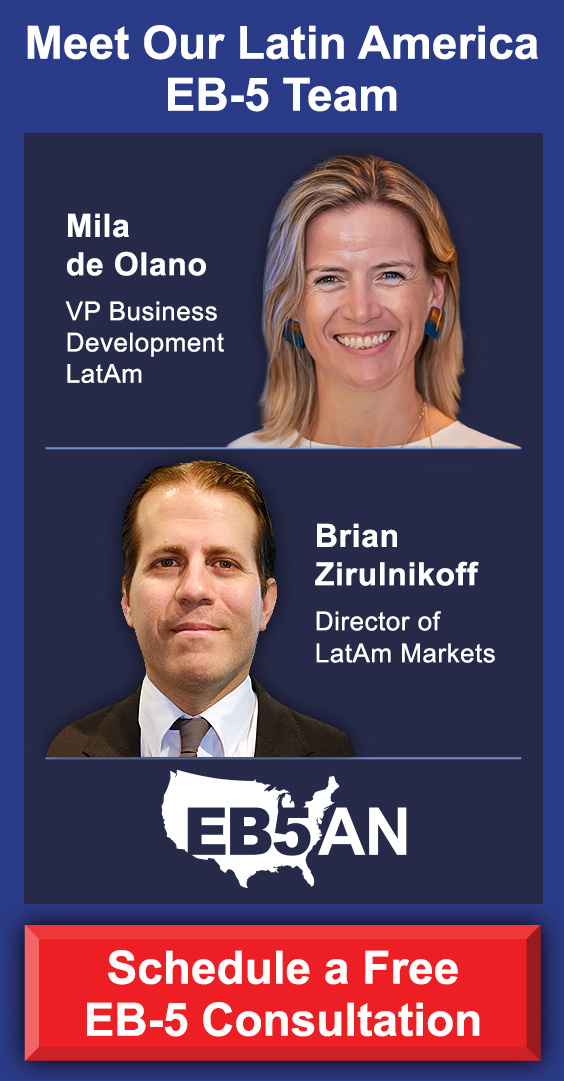Read Our Open Letter to President Trump
On February 25, 2025, President Trump announced that he intends to create a new investment-based immigration program that he says would replace the EB-5 visa program. Under Trump’s plan, foreign nationals could qualify for “Green Cards plus benefits” and an eventual path to U.S. citizenship by investing $5 million.
The President’s remarks have made headlines and have drawn the attention of all EB-5 stakeholders. And while this news is causing some anxiety, under law, the President cannot unilaterally change U.S. immigration law. Any changes to immigration programs like EB-5 must be made by the U.S. Congress.
In this post, we briefly examine President Trump’s announcement and its potential impact on the EB-5 program.
Trump’s Proposed “Gold Card” Program
What’s Next for the EB-5 Program?
- 1. Only Congress Can Amend Immigration Law and Modify the EB-5 Program
- 2. It’s Unclear How President Trump Will Proceed
Key Takeaways
Watch Full Webinar
Watch Webinar Highlights
Trump’s New $5M Gold Card Program
Trump’s Proposed “Gold Card” Program
President Trump outlined a new “Gold Card” program similar to EB-5. Under this program, foreign nationals would apparently qualify for Green Cards through an investment in the United States. He said, “It’s going to be a route to citizenship, and wealthy people will be coming into our country by buying this card. They’ll be wealthy, and they’ll be successful, and they’ll be spending a lot of money and paying a lot of taxes.”
Unlike the EB-5 program, though, Trump said that companies could also purchase “Gold Cards” for talented or skilled employees. The new program might also offer tax benefits to investors, requiring them to pay taxes only on domestic income, not global income.
The most crucial difference between this “Gold Card” program and the EB-5 program is the apparent lack of any kind of job-creation requirement for “Gold Card” investors. For EB-5 investors, job creation is the main requirement in obtaining a Green Card.
While the President’s proposed program would not directly require job creation, the intent is to draw high net worth individuals to the United States. According to President Trump, these immigrants are likely to create jobs: “It’ll be for people with money or people who create jobs […] You’re getting big taxpayers and big job creators.”
Regarding the “Gold Card” program, Commerce Secretary Howard Lutnick said that “wealthy applicants will pay $5 million directly to the U.S. government.” Under the EB-5 program, applicants invest in commercial enterprises, often real estate developments. Aside from USCIS application and visa processing fees, which are meant to cover processing costs, EB-5 investors do not pay the U.S. government directly.
President Trump also suggested that his administration could sell as many as one million “Gold Cards,” and that proceeds from this program could help reduce the national debt. This suggests another key difference between the “Gold Card” program and EB-5—while EB-5 visas are limited, it seems these “Gold Cards” would not be capped.
What’s Next for the EB-5 Program?
For the moment, the President has taken no concrete actions toward initiating the new “Gold Card” program or ending the EB-5 program. Almost no details are available regarding President Trump’s plans. It is entirely uncertain whether the EB-5 program will be replaced, modified, or left untouched.
While we can only speculate about the “Gold Card” program and President Trump’s plans, we can offer some key insights based on what we know about the EB-5 program.
1. Only Congress Can Amend Immigration Law and Modify the EB-5 Program
The U.S. Constitution vests Congress with the exclusive power over immigration law. Article I, Section 8, Clause 4 directs that “The Congress shall have Power … To establish an uniform Rule of Naturalization.” Rules that determine who may enter and remain in the country can only be set by Congress, not the executive branch.
The Supreme Court has consistently upheld Congress’s authority over immigration law. In Chae Chan Ping v. United States (1889), the Supreme Court upheld that the power to regulate immigration is an inherent aspect of national sovereignty. The Court noted that the authority to exclude aliens is reserved for the legislative branch, reflecting the will of the people.
Furthermore, in Youngstown Sheet & Tube Co. v. Sawyer (1952), the Court limited the President’s power when it conflicts with Congressional authority, underscoring that unilateral executive actions cannot alter statutes enacted by Congress.
The EB-5 Immigrant Investor Program was enacted by Congress in 1990. Because it is codified law, any change—whether to terminate the program or replace it with a “Gold Card” system—would require a new statute. Again, a remark by a president or an executive order cannot modify or nullify the EB-5 program.
President Trump’s recent remarks about ending EB-5 and replacing it with a “Gold Card” system—while politically provocative—carry no legal effect.
Changing immigration law involves a long process: a bill must be drafted, it must be reviewed in committee, then it is debated in both the House and Senate, and finally, if passed by Congress, it must be signed by the President. The President cannot compel Congress to pass a law. And if Congress were to choose to pursue President Trump’s plan, the legislative process takes time.
While President Trump may try a novel approach to sell “Gold Cards,” he is highly limited in what he can change about settled immigration law.
The American Immigrant Investor Alliance (AIIA), an EB-5 trade association, published an analysis of the potential outcomes for the EB-5 program following President Trump’s announcement. Notice the following description of the legislative process for modifying immigration law, including changes to the EB-5 program:
Should the Trump administration actually seek to end the EB-5 program, it would need its Republican allies in Congress to introduce a bill to do so. Such legislation would need to pass both houses of Congress, including the Senate, where standing rules require the invocation of “cloture” to limit debate and advance a bill to a final vote — else, the bill may be “filibustered.” Invoking cloture requires 60 votes, and Senate Republicans (many of them supporters of the EB-5 program) only number 53. Unless the administration can convince at least seven Democratic senators to vote in favor of such a bill (which is unlikely), assuming that all Senate Republicans support it, any legislation to abolish and/or replace the EB-5 program will never be passed.
The Immigration and Nationality Act (8 U.S.C. § 1151–1153) allocates a yearly supply of visas for each employment-based visa category, including EB-5.
In its current form, the EB-5 program was signed into law in March 2022 through bipartisan support in Congress. The EB-5 Regional Center Program is valid through 2027, and the direct investment model does not require periodic reauthorization.
2. It’s Unclear How President Trump Will Proceed
President Trump is expected to provide more details on his “Gold Card” in the coming weeks. Until then, it is unclear how he will proceed.
With his background in real estate, the President is likely aware of the significant benefits of EB-5 funding for U.S. developers. President Trump’s own developments have been linked to EB-5 funding in the past. How likely is it that the President will seek to end the EB-5 program? We simply cannot tell, yet.
Could the “Gold Card” program coexist with EB-5 as a separate option for wealthier investors? We think this is much more likely than the EB-5 program ending.
Read Our Open Letter to President Trump
Key Takeaways
While President Trump’s plans for the EB-5 program are unclear, the law governing EB-5 remains intact—for now. The regional center program is valid until 2027, and any EB-5 investors who invest before September 2026 will be “grandfathered in” if the program lapses.
Historically, USCIS has favored protecting pending EB-5 petitions in the case of major policy changes.
It is unclear how the Trump administration will proceed. For now, we encourage you to watch and wait. Too little information is available to draw any conclusions. We will bring more information and analysis in the coming days.







